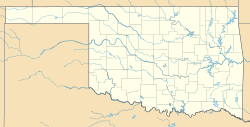Creek National Capitol facts for kids
|
Creek National Capitol
|
|
 |
|
| Location | 6th St. and Grand Ave., Okmulgee, Oklahoma |
|---|---|
| Built | 1878 |
| NRHP reference No. | 66000632 |
Quick facts for kids Significant dates |
|
| Added to NRHP | October 15, 1966 |
| Designated NHL | July 4, 1961 |
The Creek National Capitol, also known as the Creek Council House, is a very important building in Okmulgee, Oklahoma. From 1878 until 1907, it was the main government building for the Muscogee (Creek) Nation. This was before Oklahoma became a state.
In 1919, the U.S. Department of the Interior sold the building to the city of Okmulgee. It was recognized as a National Historic Landmark in 1961. In 2010, the city sold the building back to the Muscogee (Creek) Nation. Today, the building is home to the Creek Council House Museum. It has many interesting items and displays about the history of the Muscogee tribe. You can also see arts and crafts from other Native American tribes there.
Contents
A Look Back: The History of the Creek Council House
Forced Relocation and New Beginnings
In 1837, most members of the Muscogee tribe were forced to move west. This difficult journey was part of what is known as the Trail of Tears. Survivors of this journey arrived in a place called the Indian Territory. They held an important meeting under the historic Council Oak Tree in Tulsa, Oklahoma.
During the American Civil War, the tribe faced challenges. Many members fought on both sides of the war. This happened even though tribal leaders tried to stay neutral.
Building a Government Center
In 1867, the Muscogee (Creek) Nation was officially formed in the Indian Territory. Their government headquarters were set up in Okmulgee. The next year, a two-story council house made of logs was built. This was where tribal leaders met to conduct important business.
On October 17, 1877, the council decided to build a new capitol building. They approved $10,000 for a new stone or brick building. It would be built on the same spot as the old log council house. The old Council House was sold for $60 on January 10, 1878. The tribe began meeting in the new Council House on September 23 of that year. The new building had separate rooms for different parts of the government. This included the executive (leaders), judicial (courts), and legislative (law-making) branches. The legislative branch was divided into the House of Kings and the House of Warriors.
Changes and Challenges for the Nation
In 1906, the U.S. government passed the Five Civilized Tribes Act. This law ended the self-governance for the Muscogee Creek Nation and four other tribes. In 1907, the Indian Territory became part of the new state of Oklahoma.
That same year, the Muscogee Nation's Council House was rented out. Okmulgee County used it as their courthouse until 1917. In 1908, the U.S. Congress allowed the Secretary of the Interior to take control of tribal lands. This included lands used for government or schools.
The Building's New Owners and Uses
In 1919, the City of Okmulgee bought the Creek Council House and its land for $100,000. This sale was overseen by the Department of the Interior. The money from the sale was put into the U.S. Treasury for the tribe.
In the 1920s, some people in Okmulgee wanted to tear down the Council House. Others wanted to turn it into a hotel. These plans stopped when the famous entertainer Will Rogers visited the city. He spoke up and called for the Council House to be saved.
On April 24, 1923, the Creek Indian Memorial Association (CIMA) was formed. Their goal was to protect the historical sites of the Muscogee tribe. Between the 1930s and 1960s, the City of Okmulgee owned the Council House. During this time, it was used for many things. It served as a sheriff's office, a meeting room for the Boy Scouts, and a YMCA.
Return to the Muscogee Nation
In 1961, the Council House and its surrounding land were listed on the National Register of Historic Sites. It was also named a National Historic Landmark. In 1970, Congress allowed the Five Tribes to elect their chiefs again. The Muscogee (Creek) Nation elected Claude Cox as their chief the next year.
In 1979, the Muscogee (Creek) Nation created a new constitution. They also began setting aside land for new tribal government buildings. The tribal government was reorganized into executive, legislative, and judicial branches. New departments for education and health were also created.
In 1989, the CIMA raised $1 million to restore the Creek Council House. They also gained tax exempt status. The restoration of the Council House was finished in 1992. The building then opened as a museum about the Muscogee tribe's history. In 1993, the Creek Council House Museum received a special award. It was the National Preservation Honor Award for its restoration work.
In 1997, the City of Okmulgee agreed to pay the CIMA $149,650 each year to run the museum. In 2005, the CIMA changed its name to the Creek Council House Museum Association.
In August 2010, after many discussions, the City of Okmulgee agreed to sell the Council House back to the Muscogee (Creek) Nation. The price was $3.2 million. Two months later, a special ceremony was held. It celebrated the building being returned to the Muscogee (Creek) Nation.



